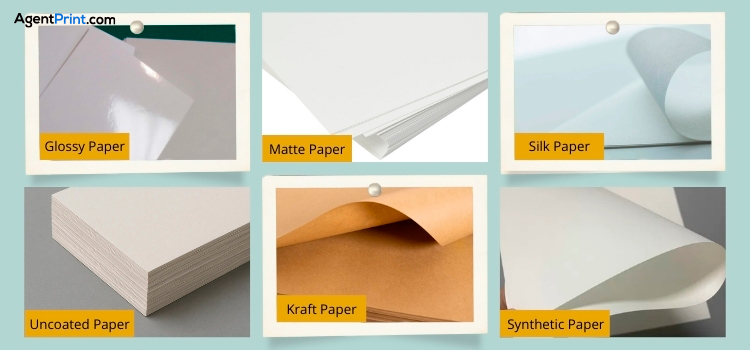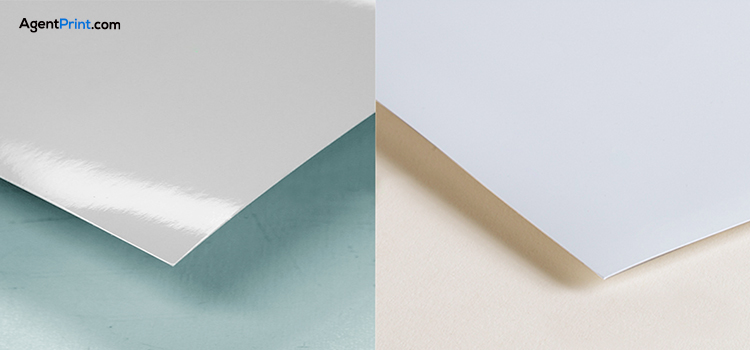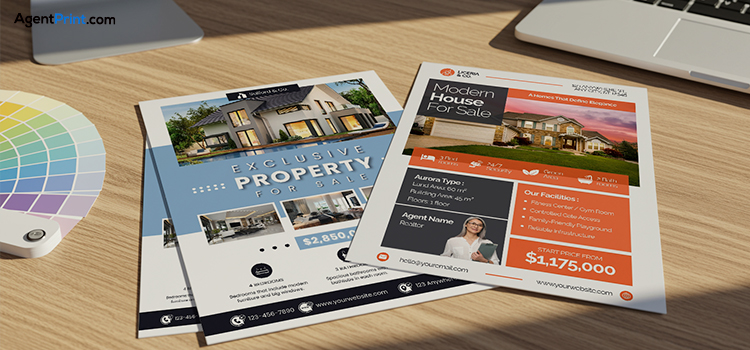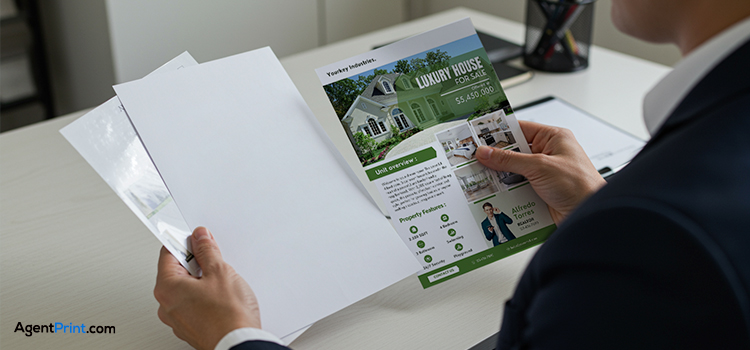Are you planning to create real estate flyers that grab attention and differentiate your brand identity? One of the most essential steps to take is selecting the right flyer paper if you want to achieve polished, noticeable results. Then, you need to find out which paper weight and finish will make your message stand out and which flyer layout is appropriate for what type of marketing. In this article, we are going to explore important real estate flyer printing tips to help you find the best options for the highest-quality results.
Read More: Real Estate Flyer Examples and Templates That Actually Work
Paper Types for Real Estate Flyer Printing Tips

Flyers can be printed on various paper types, each of which has a unique look, feel, and durability. Among the most popular types of flyer papers include:
- Glossy Paper: This paper type has a shiny and smooth surface that makes colours and images glow and stand out. It’s a common option for visually striking flyers or marketing materials that need an instant impact, such as those that feature images or striking patterns. Under some lighting circumstances, glossy paper may be more vulnerable to glare and fingerprints.
- Matte Paper: Unlike glossy paper, matte paper has a smooth, non-reflective surface that makes it perfect for flyers with a lot of text, since it makes it easier to read and reduces glare. Compared to glossy paper, it has a more elegant and polished appearance. On matte paper, however, colours could seem a little less vivid.
- Silk/Satin Finish Paper: This paper has a delicate sheen that improves colour reproduction without the sharp reflections of glossy paper, striking a balance between glossy and matte finishes. It is a well-liked option for premium flyers that need to be both aesthetically pleasing and readable since it has a smooth, sophisticated feel.
- Uncoated Offset Paper: The natural, uncoated surface of this cost-effective alternative promotes good ink absorption, producing text that is readable and clear. It’s a wonderful option for projects with a tight budget or for printing a lot of flyers, especially ones with a lot of text. It might not, however, provide as much colour brightness as coated papers.
- Cardstock: A thicker, heavier paper stock with improved durability and a high-end feel. Cardstock is appropriate for flyers or other high-end promotional materials that will be handled frequently. Cardstock comes in a variety of weights to accommodate different thicknesses and rigidity levels.
- Synthetic Paper (Yupo/Teslin): This synthetic paper, which is waterproof and rip-resistant, is incredibly durable and made from materials like polypropylene.
- Kraft Paper: Usually composed of recycled materials, this paper has a rustic, natural brown colour. It works well for companies that care about the environment or those who like an organic look.
Paper Weight Considerations

For paperweights, you need to consider a balance between durability, affordability, and fine appearance. While thicker weights (170-250 gsm) provide a more upscale feel and durability for real estate flyers, lighter weights (130-170 gsm) are appropriate for high-volume, cost-effective distribution. The most important issues to think about before printing include:
- Aesthetic: The flyer’s overall appearance and feel can be greatly influenced by the weight of the paper. While lighter paper could be better suited for a more informal or promotional tone, heavier paper can convey a sense of quality and elegance.
- Printing Technique: When selecting a paper weight, take into account that certain printing techniques, especially those that use thicker stocks, may require specific tools.
- Distribution Strategy: Consider the flyers’ intended distribution strategy. It could be better to use a little heavier weight if they are being distributed. For direct mail purposes, lower weights could be more affordable and manageable.
- Objective: One important consideration is the flyer’s goal. Lower-weight papers might be adequate for a simple informational flyer.
Choosing the Best Paper
Silk paper is generally the ideal option for flyers because it strikes a good balance between readability and aesthetic appeal. A common weight for silk paper is 150 gsm, which offers a polished, lightly coated appearance. On the other hand, glossy paper is best for highly visual designs that call for vivid colours, while uncoated paper is a fantastic substitute for flyers with a lot of text.
Read More: An All-Inclusive Guide to Flyer Dimensions and Size Options
Colour Printing Tips to Highlight Property Features

For a better impression, consider using high-quality, high-contrast photos, and pick colours that inspire customers positively. You should manage the colours to balance between screen and print when highlighting property features on real estate flyers. To increase impact, use complementary colour combinations for focal points and a consistent colour scheme based on colour psychology. Here’s a more thorough explanation:
- Superior Quality Pictures: To highlight the best aspects of the property features, use expertly taken, high-quality pictures. This factor is one of the most important issues to consider.
- Contrast: There should be enough contrast between the background colours and the text, as well as between the photos and the background.
- The Hierarchical Structure: Highlight key information and direct the reader’s attention with different font sizes and spacing.
- Think About Glossy Paper: Glossy paper can enhance colours and give your flyer a more opulent appearance.
- Brand Consistency: Make use of colours that complement your brand identity to achieve a unified aesthetic with other print marketing materials.
- Psychological Impact: Select colours that transfer special feelings connected to the home, such as coziness, safety, and elegance.
- White Space: To prevent a cluttered appearance and direct the reader’s attention, make sure the flyer has enough white space.
Where to Print Real Estate Flyers in Canada?
After considering the above-mentioned factors while planning to print real estate flyers, the next and most important thing to do is to find a trusted print partner. AgentPrint.com, with long-term experience and expertise in printing real estate marketing materials, is right by your side and ready to complete this mission. We have a professional team to guarantee the highest quality for designing and printing your advertising tools. You can also enjoy our special free shipping offer for some Canadian provinces (check the details here). Put in your order right now!
Final Words
You can create a flyer that attracts potential buyers, highlights the property’s best qualities, and eventually results in a successful marketing campaign by adhering to these essential guidelines. Consider the paper weight, special colour scheme, and your brand components to design and print an eye-catching real estate flyer. Good luck!
